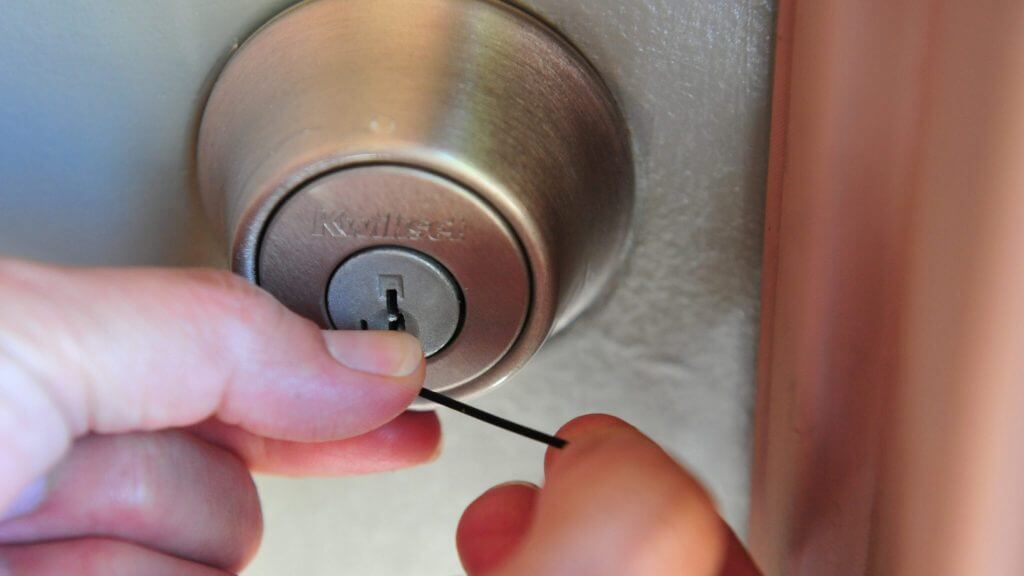You may have forgotten your key and never been able to go home. Between frustration and annoyance, staying locked out is often a horrible experience. However, be aware that it is possible to unlock your lock with only two hairpins. Lock picking, also called a fine opening, is a technique of opening a lock that requires only two tools, a coach and a hook. Make these instruments with your hairpins and use them with patience and skill to be able to go home.
Prepare the pins
1-Make your hook.
Start by fully extend one of the two hairpins. It should form a long, flat piece of metal. It will allow you to move the pins located in the cylinder. Therefore, it schematically replaces the notched side of the key.
Remove any end caps that protect the ends of the pin. Generally, they can easily remove with your fingers or teeth. If you can, you can use a tool such as wire cutters.
2- Curl one end of the Bobby pin to form a hook.
To do this, insert the object into the cylinder of the lock. It is the metal part into which the key is inserted. Push the end of the pin in for about a centimeter, keeping the flat side towards you. Then push the pin five to ten centimeters to the left to twist it.
There is no need to bend the pin at right angles. The main thing is that the curvature is sufficient to be able to press the pins located in the cylinder.
3– Bend the other end of the pin to create a ring.
This will allow you to have a better grip on the instrument.
4- Make your coach.
Also called tensor or tensioner, the trainer replaces the flat side of the key. Bend the pin “L” until it forms a right angle. This is obviously easier with a tool such as pliers, but the hairpins are flexible enough to be twisted with your bare hands. If the pin is thick, you can just separate the two branches until they form a right angle.
5- Understand the mechanism of a lock.
Conventional locks are so-called pin models. The heart of the mechanism is formed by the cylinder, made up of two parts. It has a fixed part, the stator, and a mobile part, the rotor. Under the action of the key, the rotor turns and engages the mechanism for opening the lock. Pins are small metal rods that lock the rotor in the absence of a key. Each pin is formed by an active part that moves under the action of the key. While a passive part which prevents rotation of the rotor. The pins connect with the springs, which allows them to fit into the relief of the key. When the latter is fully inserted, the two sides of the pins align with the shear line. It is the space between the rotor and the stator. This frees the rotor.
Pick the lock
1-Insert your makeshift trainer.
Introduce the shortest part of the pin into the top of the cylinder. Press with your thumb at the fold to maintain sufficient pressure on the rotor.
2- Turn the coach as if it were your key.
You should feel a slight play in the rotor, similar to that observed when you turn a key in the lock to verify that it is locked. Be sure to maintain a constant pressure. This tension is essential for successful picking, as it allows you to feel the movement of the rotor.
If in doubt about the direction of rotation of the key to open the door, try both directions. If you wave the pin in the wrong direction, you will feel resistance in the rotor.
3-Insert your hook-shaped pin.
Direct the curvature toward the pins. Count the number bypassing the hook on their top. This allows you to estimate the safety level of your cylinder and the picking time. Feel the pins one at identifying those who are the most difficult to get off.
The hook allows the pins to be pushed in to align them with the hyphenation line. So be sure to turn the curved end down.
If no pin moves, the tension exerted on the drive is surely too strong. In this case, all the pins will indeed block. Release the pressure on the coach or remove it and try again.
4-Look for pins that are difficult to move.
Among them, identify the stationary pin. While keeping constant pressure on the coach, press the hook against the pin until you hear a sufficiently loud click. This means that the junction between the active part and the passive part will align with the line of cut. It is, therefore, no longer an obstacle to the rotor.
When you insert a pin, the rotor turns slightly in the opening direction. It will occur under the effect of the tension applied to the driver.
5-Do the same pin by pin.
When you place a pin, another one stops. Find it and press it until it lines up with the hyphen. Work pin by pin without releasing the pressure on the coach.
The working pin is always a stationary one. You can only identify it bypassing your hook over all the pins each time.
Keep constant pressure on the coach to gradually unlock the lock.
Press the pin until you hear a clicking sound.
Go to the next pin without losing focus. Align all the pins, then move the driver one last time to unlock the lock fully.
6- Adjust the pressure on the coach.
Finding the right pressure is one of the challenges of picking. If it is too strong, the pins are all blocked, preventing their movement. If the pressure is too low, the pins are not positioned correctly, and it isn’t very easy to identify which one to move. If you release the stress during picking, the pins will resume their position, forcing you to start all over again. The best solution is to begin by applying fairly intense pressure and then gradually relax. Take the time to find the right pressure from the start to get your picking done as quickly as possible.
To know more, click here.






